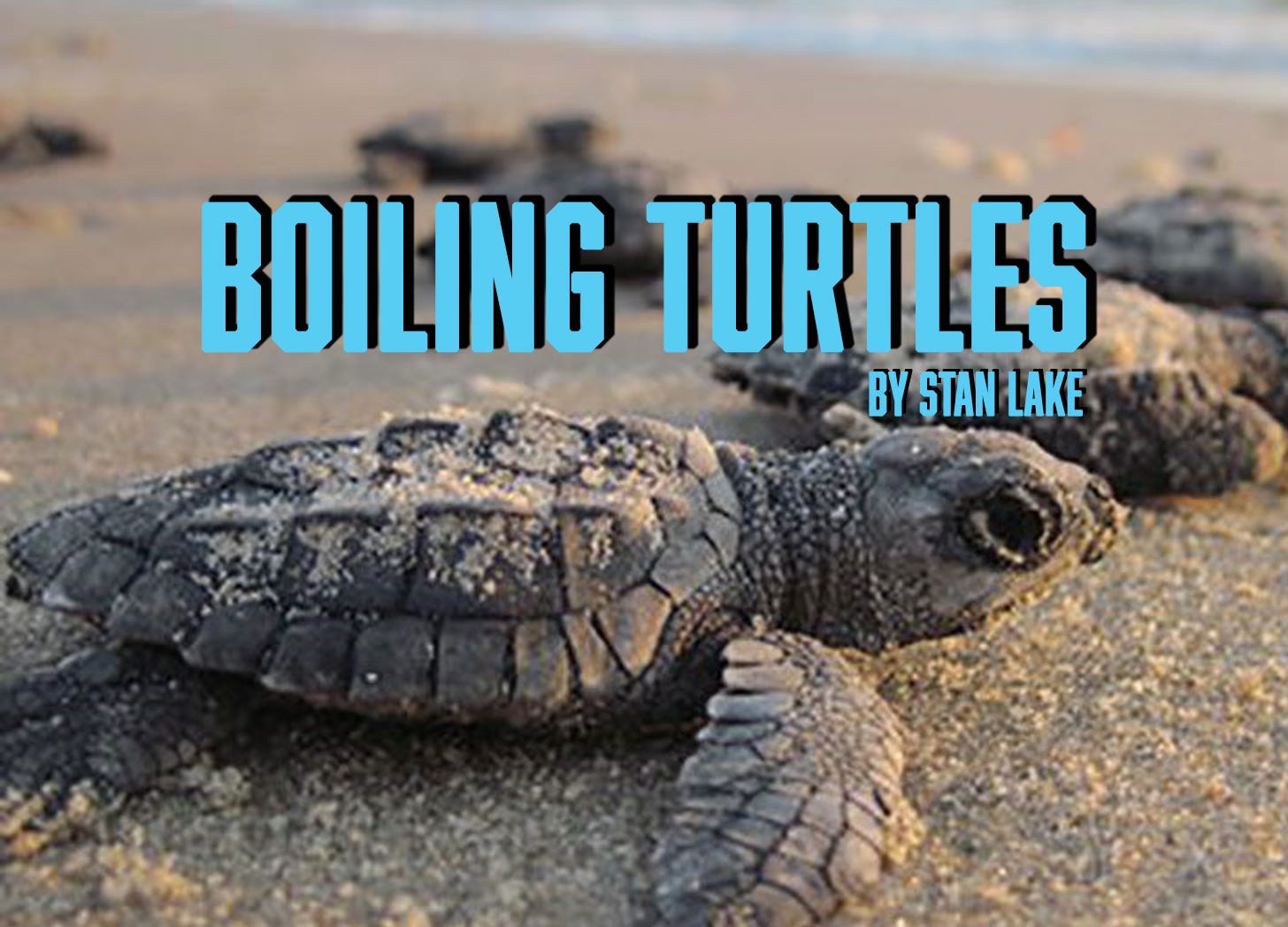Boiling Turtles
We waited with palpable anticipation shoulder to shoulder with over a hundred strangers in complete darkness. The humid coastal air was charged with excitement. It felt reverent. Magic was afoot. For over two hours, we waited. Then at 11:30 pm, we left. Defeated.
The next evening, we arrived much earlier at the collapsing sea turtle nest. Today would be the day. They almost guaranteed it. We were skeptical, having spent fruitless hours the night before. Yet, we decided to see this thing through. After a welcome meal with my cousin, his family, and my great-aunt, we decided to try our luck with the sea turtles again. We figured they surely hatched already, so we were prepared to see an empty nest. That is not what we saw when we arrived. It felt like a carnival of eager chelonian fans.
We started our vigil at 8:00 pm. Storm clouds bubbled along the horizon’s edge. Whether it was to be rain or high tide, we were in it. As the barometric pressure dropped and the tide rose closer to its peak, movement began. Gasps erupted from the enthusiastic crowd. With each new fracture in the nest’s surface, expectant onlookers craned their necks to evaluate any change perceived to be happening below the nest’s surface. Everyone had their theories of when the hatchlings would emerge. We waited impatiently, letting anxious conversations stop and start among ourselves.
An hour elapsed, and the mood went from elation to collective rage as one of the sea turtle volunteers greedily positioned herself and a stack of her things in the sightline of around twenty-five of us. We asked the dried-up raisin of a woman to please move, or at the very least, reposition her pile of unnecessary things so the rest of us could see. “This is my first boil,” she hissed with entitlement dripping from her reptilian mouth. Doubling down, she positioned herself and her things to block even more of our view. God bless her. The crowd was ready to boil her alive.
Then, someone snapped a photo, and their flash accidentally went off. One of the volunteers screeched a shrill rebuke to “turn off all lights and flashes” in a tone that I can only describe as hateful. Some of the volunteers of the Ocean Isle Beach Sea Turtle Protection Organization became quite nasty with the crowd at times. On one occasion, the previous night, curses were hurled furiously at an elderly woman who couldn’t figure out how to turn down the brightness on her phone. Their make-believe authority felt like something straight out of the Stanford prison experiment, where guard uniforms were traded for pink volunteer shirts. We learned to loathe them as we waited for the hatchlings to arise.
A little after 9:00 pm, it began. My wife started squealing, then crying with joy as the tiny loggerhead sea turtle hatchlings boiled out of their sandy nest. This was one of those moments that are far too rare these days. Collective wonder washed over the group, and we watched as scores of little blurry black reptiles scuttled towards the Atlantic Ocean. The path to the sea was protected, and a sort of chute was constructed to direct them into the waiting waves. In less than ten minutes, they were mostly all in the water. After straining to see little black dots enter the water, I walked back up to the nest to catch a couple of stragglers amble their way out of the hole and slowly towards their kin.
The sad truth about this experience is that, as much as it excites me to know that they all safely exited the nest and entered the ocean, over 99% won’t survive to see their first birthday. This accounts for the large nest sizes, and hope against hope, it becomes a numbers game. Baby sea turtles are a favorite meal for many things in the ocean. Aside from predation, habitat loss, rising ocean temperatures, overfishing, pollution, and discarded fishing equipment all pose threats to sea turtles. If you add hunting pressure and outdated beliefs about consuming turtle eggs in other countries, you can see why loggerheads are an endangered species.
Although many of the volunteers we encountered were aggressive with onlookers and at times downright mean or entitled, they weren’t all bad. I mean, I get it. They care. Their passion for the turtles superseded their self-awareness of how they were treating those around them. At the end of the day, their diligence in watching after the turtles and their nests is why so many successfully survive those critical first few moments. Their love for these animals and their well-being is commendable, regardless of any hurt feelings they may have caused. It was emotional for all of us.
If they can beat the odds and survive, these tiny hatchlings will grow to be well over three hundred pounds. It takes females somewhere between fifteen and thirty years to become sexually mature. Then, they live on average to their late forties to early sixties at the max end of their life expectancy. This is why seeing moments of natural wonder like these is so special. One day, a few decades from now, some of these hatchlings may return to this very beach to lay eggs. I hope for both our sakes that I’m here to see it.





What an awesome experience!!! Thank you for sharing!!!
Glad you both got to witness this. Sorry about the Karen’s!! I’m sure it was a wonderful experience anyway. Love and hugs!